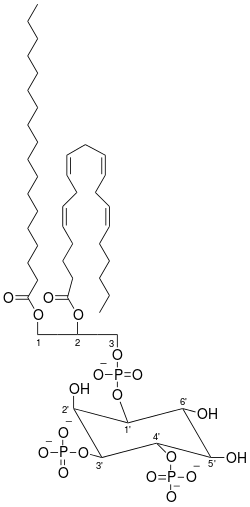Phosphatidylinositol 3,4-bisphosphate
Phosphatidylinositol (3,4)-bisphosphate (PtdIns(3,4)P2) is a minor phospholipid component of cell membranes, yet an important second messenger. The generation of PtdIns(3,4)P2 at the plasma membrane activates a number of important cell signaling pathways.[1]

PtdIns(3,4)P2 is dephophosphorylated by the phosphatase INPP4B on the 4 position of the inositol ring and by the TPTE (transmembrane phosphatases with tensin homology) family of phosphatases on the 3 position of the inositol ring.
The PH domain in a number of proteins binds to PtdIns(3,4)P2 including the PH domain in PKB. The generation of PtdIns(3,4)P2 at the plasma membrane upon the activation of class I PI 3-kinases and SHIP phosphatases causes these proteins to translocate to the plasma membrane, thereby affecting their activity.
References
- Dimitrios Karathanassis; Robert V. Stahelin; Jerónimo Bravo; Olga Perisic; Christine M Pacold; Wonhwa Cho; Roger L Williams (2002). "Binding of the PX domain of p47phox to phosphatidylinositol 3,4-bisphosphate and phosphatidic acid is masked by an intramolecular interaction". EMBO Journal. 21 (19): 5057–5068. doi:10.1093/emboj/cdf519. PMC 129041. PMID 12356722.